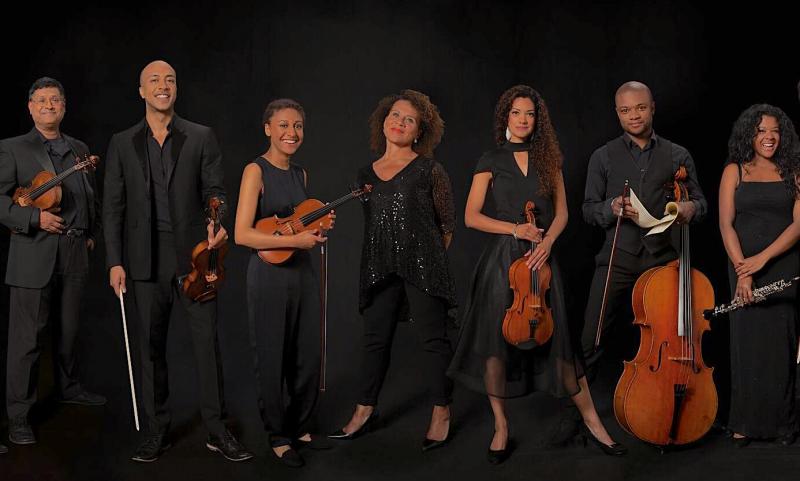Goodyear, Chineke! Orchestra, Marshall, Symphony Hall, Birmingham Review - engaging and uplifting | reviews, news & interviews
Goodyear, Chineke! Orchestra, Marshall, Symphony Hall, Birmingham Review - engaging and uplifting
Goodyear, Chineke! Orchestra, Marshall, Symphony Hall, Birmingham Review - engaging and uplifting
Joy and sparkle from this youthful band

Having played their first concert just four years ago, the Chineke! Orchestra gave a rousing, exuberant performance for an ensemble still in its infancy. It’s a young orchestra, not just in the sense of only being founded a few years ago, but one that comprises many young players too. Though its youthful passion and energy was very much to the fore, there were some points in Edvard Grieg’s Peer Gynt Suite No 1 when a lack of experience let them down.
Stewart Goodyear’s Callaloo – A Caribbean Suite for Piano and Orchestra had all the joy and colour of a Caribbean carnival, with the composer himself at the keyboard. Named after a Caribbean dish that blends flavours and spices, the piece mixes musical influences, from calypso to jazz, Afro-Cuban and Jamican folk, as well as classical. The first movement, "Panorama", is inspired by steel pan groups playing medleys of calypso songs, and seemed to exude sunshine in this high-spirited performance. The second, "Mento", is an homage to the Jamican musical style of the same name and features driven rhythms from strings and horn.  Goodyear’s playing (the pianist/composer pictured above by Anita Svonar) switched from punchy and flamboyant to tender and lyrical for the third movement, "Ballad", before giving bright splashes of colour to his cadenza. Moving straight into the final movement, "Soca", which takes its name from the Carnival’s grand finale, the orchestra played with an infectious energy, with brilliant trumpets and zesty percussion. Conductor Wayne Marshall seemed almost to be dancing on the podium as he brought the exhilarating final movement to an end.
Goodyear’s playing (the pianist/composer pictured above by Anita Svonar) switched from punchy and flamboyant to tender and lyrical for the third movement, "Ballad", before giving bright splashes of colour to his cadenza. Moving straight into the final movement, "Soca", which takes its name from the Carnival’s grand finale, the orchestra played with an infectious energy, with brilliant trumpets and zesty percussion. Conductor Wayne Marshall seemed almost to be dancing on the podium as he brought the exhilarating final movement to an end.
The audience was a particularly enthusiastic one, giving rapturous applause at the end of every movement of every piece. Even the stage manager was heartily clapped as he came on to lift the piano lid ahead of Goodyear’s performance. Though clapping in between movements is, in today’s classical music circles, strictly Not. The. Done. Thing., the fact that this orchestra brought in a new audience, unused to the unwritten conventions of a concert hall, can only be a positive, and perhaps other groups could take note.
To end the programme, the orchestra captured the dark, brooding atmosphere of Dvořák’s Seventh Symphony. Though it wasn’t without its wobbles, the problems of the earlier Grieg had all but vanished, and the orchestra played with a much more mature sound than in the earlier works. Marshall took measured control over the music’s ebb and flow, not letting its energies bubble over. The lilting of the Scherzo lent the music a joyous feel despite its minor key, and the finale was played with a strong, exacting sound.
rating
Explore topics
Share this article
The future of Arts Journalism
You can stop theartsdesk.com closing!
We urgently need financing to survive. Our fundraising drive has thus far raised £49,000 but we need to reach £100,000 or we will be forced to close. Please contribute here: https://gofund.me/c3f6033d
And if you can forward this information to anyone who might assist, we’d be grateful.

Subscribe to theartsdesk.com
Thank you for continuing to read our work on theartsdesk.com. For unlimited access to every article in its entirety, including our archive of more than 15,000 pieces, we're asking for £5 per month or £40 per year. We feel it's a very good deal, and hope you do too.
To take a subscription now simply click here.
And if you're looking for that extra gift for a friend or family member, why not treat them to a theartsdesk.com gift subscription?
more Classical music
 theartsdesk at the New Ross Piano Festival - Finghin Collins’ musical rainbow
From revelatory Bach played with astounding maturity by a 22 year old to four-hand jazz
theartsdesk at the New Ross Piano Festival - Finghin Collins’ musical rainbow
From revelatory Bach played with astounding maturity by a 22 year old to four-hand jazz
 First Person: Manchester Camerata's Head of Artistic Planning Clara Marshall Cawley on questioning the status quo
Five days of free events with all sorts of audiences around Manchester starts tomorrow
First Person: Manchester Camerata's Head of Artistic Planning Clara Marshall Cawley on questioning the status quo
Five days of free events with all sorts of audiences around Manchester starts tomorrow
 Goldscheider, Brother Tree Sound, Kings Place review - music of hope from a young composer
Unusual combination of horn, strings and electronics makes for some intriguing listening
Goldscheider, Brother Tree Sound, Kings Place review - music of hope from a young composer
Unusual combination of horn, strings and electronics makes for some intriguing listening
 theartsdesk Q&A: composer Donghoon Shin on his new concerto for pianist Seong-Jin Cho
Classical music makes its debut at London's K-Music Festival
theartsdesk Q&A: composer Donghoon Shin on his new concerto for pianist Seong-Jin Cho
Classical music makes its debut at London's K-Music Festival
 Helleur-Simcock, Hallé, Wong, Bridgewater Hall, Manchester review - moving lyricism in Elgar’s concerto
Season opener brings lyrical beauty, crisp confidence and a proper Romantic wallow
Helleur-Simcock, Hallé, Wong, Bridgewater Hall, Manchester review - moving lyricism in Elgar’s concerto
Season opener brings lyrical beauty, crisp confidence and a proper Romantic wallow
 Kohout, Spence, Braun, Manchester Camerata, Huth, RNCM, Manchester review - joy, insight, imagination and unanimity
Celebration of the past with stars of the future at the Royal Northern College
Kohout, Spence, Braun, Manchester Camerata, Huth, RNCM, Manchester review - joy, insight, imagination and unanimity
Celebration of the past with stars of the future at the Royal Northern College
 Jansen, LSO, Pappano, Barbican review - profound and bracing emotional workouts
Great soloist, conductor and orchestra take Britten and Shostakovich to the edge
Jansen, LSO, Pappano, Barbican review - profound and bracing emotional workouts
Great soloist, conductor and orchestra take Britten and Shostakovich to the edge
 Jakub Hrůša and Friends in Concert, Royal Opera review - fleshcreep in two uneven halves
Bartók kept short, and a sprawling Dvořák choral ballad done as well as it could be
Jakub Hrůša and Friends in Concert, Royal Opera review - fleshcreep in two uneven halves
Bartók kept short, and a sprawling Dvořák choral ballad done as well as it could be
 Hadelich, BBC Philharmonic, Storgårds, Bridgewater Hall, Manchester review - youth, fate and pain
Prokofiev in the hands of a fine violinist has surely never sounded better
Hadelich, BBC Philharmonic, Storgårds, Bridgewater Hall, Manchester review - youth, fate and pain
Prokofiev in the hands of a fine violinist has surely never sounded better
 Monteverdi Choir, ORR, Heras-Casado, St Martin-in-the-Fields review - flames of joy and sorrow
First-rate soloists, choir and orchestra unite in a blazing Mozart Requiem
Monteverdi Choir, ORR, Heras-Casado, St Martin-in-the-Fields review - flames of joy and sorrow
First-rate soloists, choir and orchestra unite in a blazing Mozart Requiem
 Cho, LSO, Pappano, Barbican review - finely-focused stormy weather
Chameleonic Seong-Jin Cho is a match for the fine-tuning of the LSO’s Chief Conductor
Cho, LSO, Pappano, Barbican review - finely-focused stormy weather
Chameleonic Seong-Jin Cho is a match for the fine-tuning of the LSO’s Chief Conductor
 Classical CDs: Shrouds, silhouettes and superstition
Cello concertos, choral collections and a stunning tribute to a contemporary giant
Classical CDs: Shrouds, silhouettes and superstition
Cello concertos, choral collections and a stunning tribute to a contemporary giant

Add comment